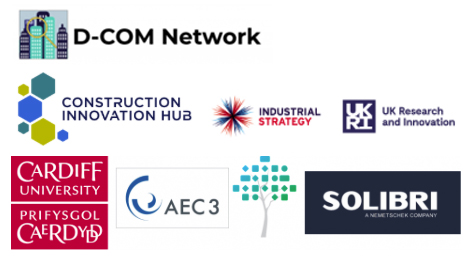Approved Documents compliance process digitalised
Contents |
[edit] A demonstration project
A demonstration project has successfully digitalised the Approved Documents compliance process.
The D-COM demonstrator project (a partnership between the Construction Innovation Hub and Cardiff University's Digital Compliance Network) has enabled the digitalisation of Approved Documents, so they are machine-readable and easier to compare against building and product information.
Also involved in D-COM were: international BIM consultancy AEC3 UK; construction software giant Solibri UK; and innovation management specialist Process Innovation Factory.
D-COM is supported by a digital ecosystem that integrates the tools and data sources that firms must use as part of the compliance process, making information more accessible and, the Hub hopes, driving greater and more consistent levels of compliance.
[edit] Real-world BIM models
D-COM's technology was run against real-world 3D BIM models in Solibri's system for the proof of concept. D-COM interprets the approved document, works out what requirements are relevant to a project, and then interfaces with Solibri (and other similar systems) to ask for feedback. Thus, a project team can get an early view of compliance failures before going to building control without much human input.
Also included are tools that create audit trails of compliance checks, which will help in fulfilling requirements for golden threads for buildings.
Dr Thomas Breach, reader at Cardiff University and D-COM Network leader, explained: "The successful development and demonstration of our prototype demonstrates the power of machine-readable construction guidance. This includes the ability to visualise and interrogate changes between document versions, as well as searching and drawing together all clauses focused on key concepts across the different documents that make up the UK construction regulatory landscape.
"This project has shown that semi-automated checking of building designs is feasible now and that its feasibility will grow as information management adoption increases."
[edit] Integrating compliance checking tools
He added: "Furthermore, it has shown that there is a large number of high-quality tools that assist in the compliance checking process already available – what is needed is the ability to integrate these tools. This is a task that the prototype developed in the project is able to do well, integrating the text of Approved Documents, high-level decision making and technical compliance checking tools, to provide a complete compliance checking solution."
Dr Ahmed Alnagger, the Hub's digital construction lead, said: "Creating that confident relationship between our buildings, linear infrastructure and trust of those who use them is essential. This connection needs a clear line-of-sight between our built assets and compliance with regulatory frameworks."
Those involved in D-COM are keen to find organisations keen to take the technology to the next stage.
The D-COM project sits alongside other projects the Hub is completing around quality assurance processes and building product information. This includes LEXiCON, which will drive the creation of standardised construction product templates. This supports the goals of D-COM by making product information easier to compare against approved documents.
This article first appearer on the CIAT news website on July 18 and is cross-referenced as having also appeared on BIM+
--CIAT
[edit] Related articles on Designing Buildings
- Approved documents.
- Approved inspector.
- Building control body.
- Building control performance standards.
- Building regulations inspection.
- BIM maturity levels.
- BIM resources.
- Construction Operations Building Information Exchange (COBie).
- Common data environment.
- Digital information.
- Digital model.
- LEXiCON
- Simplified Building Energy Model.
Featured articles and news
RTPI leader to become new CIOB Chief Executive Officer
Dr Victoria Hills MRTPI, FICE to take over after Caroline Gumble’s departure.
Social and affordable housing, a long term plan for delivery
The “Delivering a Decade of Renewal for Social and Affordable Housing” strategy sets out future path.
A change to adoptive architecture
Effects of global weather warming on architectural detailing, material choice and human interaction.
The proposed publicly owned and backed subsidiary of Homes England, to facilitate new homes.
How big is the problem and what can we do to mitigate the effects?
Overheating guidance and tools for building designers
A number of cool guides to help with the heat.
The UK's Modern Industrial Strategy: A 10 year plan
Previous consultation criticism, current key elements and general support with some persisting reservations.
Building Safety Regulator reforms
New roles, new staff and a new fast track service pave the way for a single construction regulator.
Architectural Technologist CPDs and Communications
CIAT CPD… and how you can do it!
Cooling centres and cool spaces
Managing extreme heat in cities by directing the public to places for heat stress relief and water sources.
Winter gardens: A brief history and warm variations
Extending the season with glass in different forms and terms.
Restoring Great Yarmouth's Winter Gardens
Transforming one of the least sustainable constructions imaginable.
Construction Skills Mission Board launch sector drive
Newly formed government and industry collaboration set strategy for recruiting an additional 100,000 construction workers a year.
New Architects Code comes into effect in September 2025
ARB Architects Code of Conduct and Practice available with ongoing consultation regarding guidance.
Welsh Skills Body (Medr) launches ambitious plan
The new skills body brings together funding and regulation of tertiary education and research for the devolved nation.
Paul Gandy FCIOB announced as next CIOB President
Former Tilbury Douglas CEO takes helm.
UK Infrastructure: A 10 Year Strategy. In brief with reactions
With the National Infrastructure and Service Transformation Authority (NISTA).
























